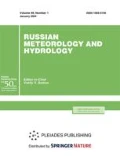Abstract
Experimental results are presented of the estimation of pollution levels of Lake Baikal unique ecosystem (air, surface and deep water, soil, bottom sediments, and aquatic biota) with persistent organic pollutants (POPs) which were included to the list of Stockholm Convention (polychlorinated biphenyls, organochlorine pesticides, toxaphene, and polybrominated diphenyl ethers). The ranges of POPs concentration are determined and statistical characteristics (mean and median) over the period of observations are calculated. It is demonstrated that the wide variation range of POPs concentration depends on environmental factors and on the POPs source (local sources or global transport).
Similar content being viewed by others
References
V. B. Batoev, O. V. Tsydenova, G. G. Nimatsirenova, and S. S. Palitsina, Persistent Organic Pollutants in the Lake Baikal Ecosystem, Ed. by D. M. Monganov (Novosibirsk, 2004) [in Russian].
A. G. Gorshkov, E. V. Dzyuba, O. V. Kustova, et al., “Bioindicators of Persistent Organic Pollutants in Lake Baikal. I. Baikal Omul (Coregonus Migratorius, Georgi, 1775),” Voda: Khimiya i Ekologiya, No. 8 (2015) [in Russian].
The State Report “Lake Baikal and Measures on Its Protection in 2014” (Siberian Branch of Rosgeolfond, Irkutsk, 2015) [in Russian].
O. V. Kustova and A. G. Gorshkov, “Level of Polychlorinated Biphenyls in Lake Baikal and Its Assessment at the Present Stage,” in Water Resources: Research and Management (Limnological School-practice). Proceedings V International Conference of Young Scientists (September 5-8, 2016), Vol. 1 (Karelian Research Centre ofRAS, 2016) [in Russian].
A. A. Mamontov, Polychlorinated Dibenzo-p-dioxins and Retated Compounds in the Lake Baikal Ecosystem (Akademiya Nauk o Zemle, Moscow, 2001) [in Russian].
E. A. Mamontova, E. N. Tarasova, S. I. Levshina, et al., “Polychlorinated Biphenyls and Organochlorine Pesticides in the Air-soil System in the South of the Russian Far East,” Meteorol. Gidrol., No. 11 (2014) [Russ. Meteorol. Hydrol., No. 11, 39 (2014)].
E. A. Mamontova, E. N. Tarasova, A. A. Mamontov, et al., “Persistent Organic Pollutants in Air over Some Areas of Siberia and the Far East of Russia,” Geografiya i Prirodnye Resursy, No. 4 (2012) [in Russian].
C.N.524.2009.TREATIES-4. Stockholm Convention on Persistent Organic Pollutants. Stockholm, 22 May 2011. Adoption of Amendments to Annexes A, B and C [Electronic Resource UNEP-POPS-TREATY-NOTIF-CN524- 2009.En.pdf].
EPA Method 525.3. Determination of Semivolatile Organic Chemicals in Drinking Water by Solid Phase Extraction and Capillary Column Gas Chromatography/Mass Spectrometry (GC/MS).
Author information
Authors and Affiliations
Corresponding author
Additional information
Original Russian Text © D.P. Samsonov, A.I. Kochetkov, E.M. Pasynkova, M.A. Zapevalov, 2017, published in Meteorologiya i Gidrologiya, 2017, No. 5, pp. 105-115.
About this article
Cite this article
Samsonov, D.P., Kochetkov, A.I., Pasynkova, E.M. et al. Levels of persistent organic pollutants in the components of the Lake Baikal unique ecosystem. Russ. Meteorol. Hydrol. 42, 345–352 (2017). https://doi.org/10.3103/S1068373917050119
Received:
Published:
Issue Date:
DOI: https://doi.org/10.3103/S1068373917050119




